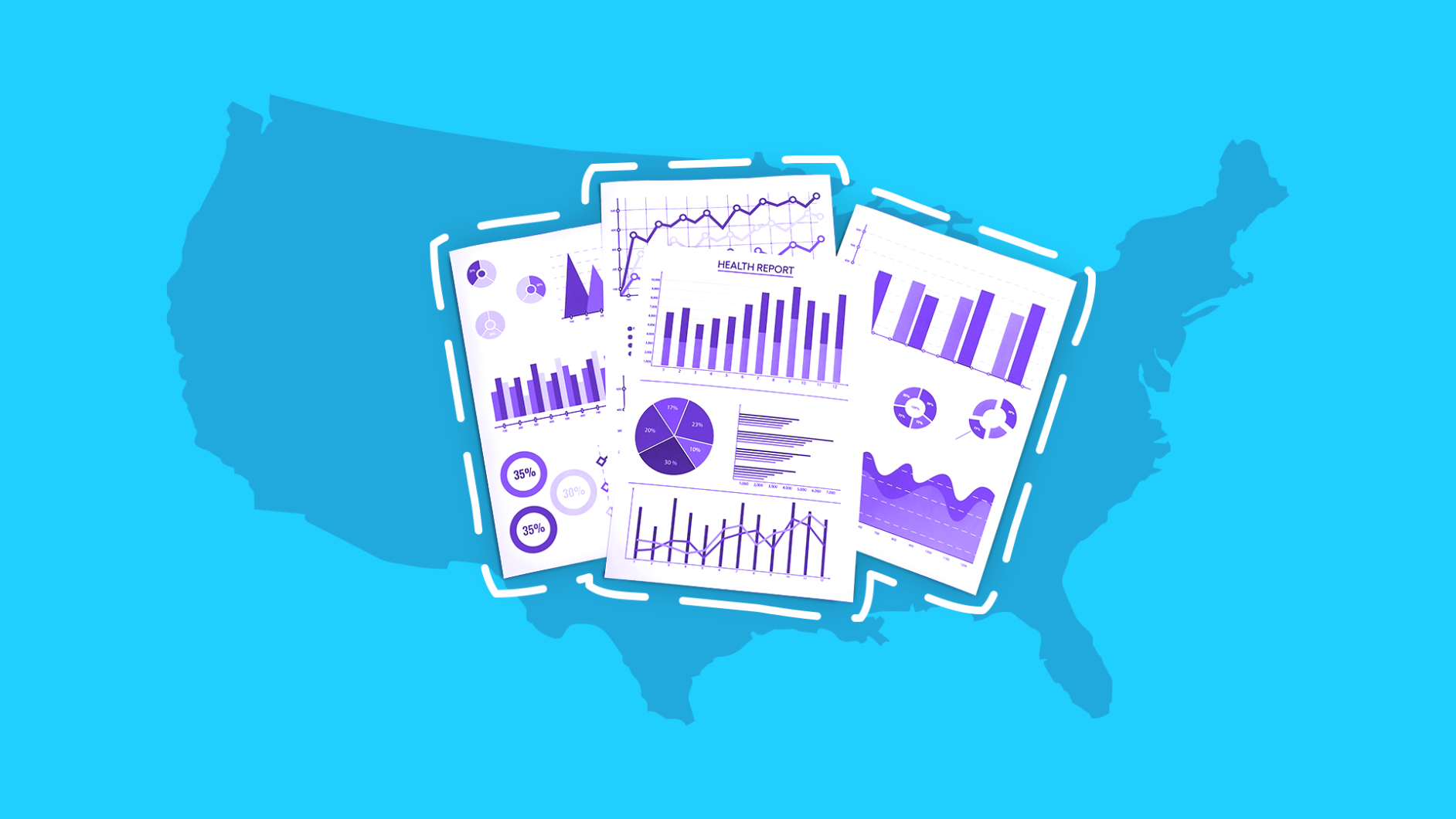What is diabetes? | How common is diabetes? | Diabetes statistics in America | Diabetes statistics by state | Diabetes statistics by type | Diabetes statistics by age | Diabetes statistics by race and ethnicity | Common complications | Cost | Prevention | FAQs | Research
Diabetes is a collection of diseases characterized by elevated blood glucose. There are multiple types of diabetes, but each involves the body’s inability to use glucose for energy. Unfortunately, diabetes is increasingly prevalent in America and around the world. How prevalent? Read on for worldwide and U.S. diabetes stats and facts.
What is diabetes?
Glucose is an essential part of our everyday functions. Our bodies use it for energy, but that requires a hormone called insulin, which is produced by the pancreas. Insulin is like a taxi for blood sugar—it takes glucose from blood and directs it to our cells, which finish the job by converting it to energy. When someone has diabetes, their body cannot produce or use insulin effectively, which leaves more glucose in their bloodstream.
RELATED: How much does insulin cost?
How common is diabetes?
Diabetes is one of the world’s fastest-growing chronic diseases. How prevalent is it? Let’s take a look:
- In 1980, 108 million people worldwide had diabetes. By 2014, that number had risen to 422 million. (World Health Organization [WHO], 2020)
- An estimated 700 million adults worldwide will have diabetes by 2045. (International Diabetes Federation [IDF], 2020)
- China has the highest number of diabetes accounts worldwide, with 116 million people with diabetes. Following China is India (77 million people with diabetes) and then the United States (31 million people with diabetes). (IDF Diabetes Atlas, 2019)
Diabetes statistics in America
- More than 34 million Americans have diabetes, which is nearly 11% of the U.S. population. (Centers for Disease Control and Prevention [CDC], 2020)
- Every 17 seconds, an American is diagnosed with diabetes. (The American Journal of Managed Care, 2018)
- There are 1.5 million new cases of diabetes in the United States each year. (American Diabetes Association [ADA], 2020)
Diabetes statistics by state
The states with the highest percentage of adults with diagnosed diabetes are:
- West Virginia (15.7%)
- Mississippi (14.8%)
- Alabama (14%)
- Tennessee (13.8%)
- Arkansas (13.6%)
- South Carolina (13.4%)
- Kentucky (13.3%)
- District of Columbia (12.8%)
- Louisiana (14.1%)
- Texas (12.6%)
- Indiana (12.4%)
The states with the lowest percentage of adults with diagnosed diabetes are:
- Colorado (7%)
- Alaska (7.3%)
- Montana (7.6%)
- Wyoming (7.8%)
- Utah (8%)
- Massachusetts (8.4%)
- Oregon (8.6%)
- Wisconsin (8.7%)
- Vermont (8.7%)
- Delaware (8.7%)
(State of Childhood Obesity*, 2020)
*The statistics are for adult cases, which were updated in September 2020
Diabetes statistics by type
There are four types of diabetes:
- Type 1 diabetes: An autoimmune attack on pancreas cells stops them from creating insulin, so people with Type 1 need to take insulin shots every day. In most cases, Type 1 diabetes is diagnosed in children and teens, but it can manifest in adults as well.
- Type 2 diabetes: People with Type 2 can produce insulin, but their bodies resist it. When blood sugar is consistently high, the pancreas continuously pumps out insulin, and eventually, cells become overexposed. Type 2 is by far the most common type of diabetes and one that typically develops in adults; however, the rate of Type 2 diabetes in children is increasing.
- Gestational diabetes: This type only occurs in pregnant women and typically goes away after childbirth; however, half of women who have gestational diabetes will develop Type 2 diabetes later in life. Treatment includes a doctor-recommended exercise and meal plan. Sometimes daily blood glucose tests and insulin injections are necessary.
- Prediabetes: Prediabetes isn’t technically diabetes. It’s more like a precursor. A prediabetic person’s blood glucose is consistently above average, but not high enough to warrant a full diabetes diagnosis. People with prediabetes can help prevent Type 2 diabetes by implementing a healthy diet, increased physical activity, and stress management.
Here’s how prevalent each type of diabetes is:
- Of the 34.2 million U.S. adults with diabetes, approximately 7.3 million of those are undiagnosed. (ADA, 2020)
- An estimated 88 million adults have prediabetes, 34.5% of the U.S. adult population. (CDC, 2020)
- About 7% of pregnant women develop gestational diabetes. (March of Dimes, 2019)
- Half of the women who have gestational diabetes will go on to develop Type 2 diabetes later in life. (CDC, 2019)
- 1.6 million Americans have Type 1 diabetes, which includes 187,000 children and adolescents. (ADA, 2020)
- Approximately 90% to 95% of all U.S. diabetes cases are Type 2. (CDC, 2019)
Diabetes statistics by age
There’s a greater prevalence of diabetes among older age groups, especially for Type 2 diabetes, which takes longer to develop.
- Of the Americans with diagnosed diabetes, 3.6 million are 18 to 44 years old, 11.7 million are 45 to 64 years old, and 11.5 million are older than 65. (CDC, 2020)
- There are 210,000 cases of diagnosed diabetes among children and adolescents younger than 20, including 187,000 cases of Type 1 diabetes. (CDC, 2020)
- Of the Americans with undiagnosed diabetes, 1.4 million are 18 to 44, 3.1 million are 45 to 64, and 2.9 million are older than 65. (CDC, 2020)
- Approximately 24.2 million adults aged 65 and older have prediabetes. (CDC, 2020)
Diabetes statistics by race and ethnicity
Diabetes prevalence also varies between different racial and ethnic groups. Here’s how the percentage of diagnosed diabetes breaks down:
- American Indians/Alaska Natives: 14.7%
- Hispanics: 12.5%
- Non-Hispanic blacks: 11.7%
- Asian Americans: 9.2%
- Non-Hispanic whites: 7.5%
(ADA, 2020)
And the number of people with diagnosed prediabetes are as follows:
- Non-Hispanic whites: 54.8 million
- Hispanics: 14.6 million
- Non-Hispanic Blacks: 11.4 million
- Asian-Americans: 5 million
(CDC, 2020)
Common diabetes complications
Diabetes isn’t a debilitating disease. Many people with diabetes can still do all of their favorite activities, as long as they maintain a healthy lifestyle. However, “living with diabetes is a daily challenge,” says Sharita E. Warfield, MD, a board-certified emergency medicine physician and the founder and CEO of Warfield Medical Group. “[An individual] can either decide to meet the challenge head-on and make the necessary lifestyle and dietary changes or go on living and eating the way that they have because they don’t feel bad.”
Those who decide to make changes have to ask questions like, “Is it too many carbs continually? Does it have added sugar? Am I getting enough fiber?” Then, “they have to figure out how to add in physical activity, ways to destress, and how to avoid toxic substances like drugs or alcohol or sugary substances that many turn to for comfort. Not only that, but a person living with diabetes also has to remember to take their insulin, oral pills, or both, and check their blood sugar levels daily.” It might seem like a lot of work, but the alternatives are sobering. Diabetes can cause other serious health problems, such as the following:
- One in 5 survey respondents reported that their symptoms lowered their overall quality of life. These respondents also reported having kidney disease and nonalcoholic fatty liver disease. (SingleCare, 2020)
- In 2017, diabetes was America’s seventh leading cause of death. It was listed as the primary cause of death on 83,564 death certificates and mentioned on a total of 270,702 certificates. (ADA, 2020)
- Adults with diabetes have a two- to three-fold increased risk of heart attacks and strokes. (WHO, 2020)
- There were 16 million diabetes-related emergency room visits in 2016 among adults aged 18 years or older. (CDC, 2020)
- There were 7.8 million hospital discharges with diabetes reported as the diagnoses. Of these discharges, 1.7 million also listed a major cardiovascular disease, including 438,000 ischemic heart diseases and 313,000 strokes. (CDC, 2020)
- Among U.S. adults aged 18 years or older with diagnosed diabetes, an estimated 37% also had chronic kidney disease. (CDC, 2020)
- Diabetes retinopathy (long-term damage to retinal blood vessels) causes 2.6% of vision loss worldwide. (WHO, 2020)
- 85% of the world’s foot amputations are a result of a diabetic foot ulcer. (The American Journal of Managed Care, 2018)
- African Americans are four times more likely than whites to have a diabetes-related amputation. (The American Journal of Managed Care, 2018)
- Every day, 230 Americans with diabetes require an amputation. (The American Journal of Managed Care, 2018)
RELATED: Diabetes treatments and medications
The cost of diabetes
- In 2020, 54% of survey respondents paid out of pocket for all of their diabetes care. (SingleCare, 2020)
- The 2017 total estimated cost of diagnosed diabetes in the U.S. was $327 billion. (ADA, 2020)
- From 2012 to 2017, people with diabetes saw their excess medical costs increase from $8,417 to $9,601. (CDC, 2020)
- 1 out of every 4 healthcare dollars spent in the U.S. is for diabetes care. (ADA, 2018)
- On average, the medical expenses of people with diabetes is more than two times higher than it would be if they didn’t have diabetes. (ADA, 2020)
RELATED: How to get free diabetic supplies
Diabetes prevention
Type 2 diabetes is incredibly widespread, but the good news is that it can be preventable (and prediabetes can be reversed). The best way to keep it at bay is by living a healthy lifestyle, which means a well-balanced diet and regular exercise.
- Diabetes can increase one’s fall risk. An adult with diabetes who’s older than 65 is 17 times more likely to fall than a younger adult without diabetes. (UC Berkeley School of Public Health, 2017) Group exercise may reduce falls by 28% to 29%. (Diabetes Care, 2016)
- People who lost 5% to 7% body weight and added 150 minutes of exercise per week decreased their risk of developing Type 2 diabetes by up to 58%, and up to 71% for people older than 60. (National Diabetes Prevention Program, 2018)
- Resistance exercises (using free weights, weight machines, resistance bands, etc.) increased strength in adults with Type 2 diabetes by 50% and improved A1C by 0.57%. (Diabetes Care, 2016)
- Diabetic women who exercised at least four hours a week had a 40% lower risk of developing heart disease than those who didn’t exercise. (Harvard)
Some risk factors are unavoidable, but others aren’t. Committing to healthy habits will help head off most of them. On an individual basis, “people can prevent or prolong the onset of prediabetes or Type 2 diabetes by maintaining a healthy weight, eating a healthy diet, and implementing 150 to 300 minutes per week of moderate physical activity,” Dr. Warfield says. “Adopting these behavior changes early in life helps improve the quality of life and prevent the onset of prediabetes, which eventually leads to Type 2 diabetes if nothing is done.”
Diabetes questions and answers
How many people have diabetes?
According to the CDC, 463 million adults have diabetes worldwide. In the United States alone, 34.2 million adults have diabetes, 10.5% of the population.
What population has the highest rate of diabetes?
In the U.S., American Indians/Alaska Natives have the highest rate of diabetes at 14.7%, according to the ADA.
Is the incidence of diabetes increasing?
Between 1990 and 2010, the number of people living with diabetes tripled and the number of new cases annually doubled. A research team at the Institute for Alternative Futures predicts the total number of Americans with diabetes (including diagnosed and undiagnosed diabetes) will increase from 35.6 million in 2015 to 54.9 million in 2030.
What are some juvenile diabetes statistics?
More commonly known as Type 1 diabetes, juvenile diabetes is typically diagnosed in children and is managed by daily insulin shots. Around 1.6 million Americans have Type 1 diabetes, including 200,000 youth, and there are approximately 64,000 new cases per year. According to JDRF, between 2001 and 2009, there was a 21% increase in Type 1 diabetes prevalence in people younger than 20.
What percent of people with diabetes have Type 2 diabetes?
The majority (90% to 95%) of people with diabetes have Type 2 diabetes.
How do people die from diabetes?
People rarely die from diabetes directly. It’s more likely that someone with diabetes will die from complications with other organs. For example, high blood sugar can damage the kidneys over a long period of time, leading to potential kidney failure. And since diabetes is often associated with cardiovascular conditions, heart failure, and stroke are other common causes of death in diabetics. In rare cases of Type 1 diabetes, a condition called diabetic ketoacidosis (very high blood glucose levels) can cause sudden death.
How many deaths are caused by diabetes each year?
Diabetes caused 4.2 million deaths worldwide in 2019. Solely in the U.S., 83,564 people died from diabetes complications in 2017.
How many people are predicted to have diabetes in the future?
The IDF predicts that 700 million people worldwide will have diabetes by 2045.
Diabetes research
- Diabetes survey shows symptoms lower quality of life in 1 in 5 patients, SingleCare
- IDF diabetes atlas, IDF
- Diabetes data and statistics, CDC
- National diabetes statistics report, CDC
- Type 2 diabetes, CDC
- Number of Americans with diabetes projected to double or triple by 2050, CDC
- Diabetes statistics, National Institutes of Health
- Statistics about diabetes, ADA
- Gestational diabetes, March of Dimes
- Diabetes in the United States, State of Childhood Obesity
- Increasing awareness this National Diabetes Month can save limbs and lives, The American Journal of Managed Care
- Economic costs of diabetes in the U.S. in 2017, Diabetes Care by the ADA
- Diabetes, WHO
- Diabetes facts and figures, IDF
- Type 1 diabetes facts, JDRF (formerly known as Juvenile Diabetes Research Foundation)
- The importance of exercise when you have diabetes, Harvard
- Why diabetes raises your risk of falling, UC Berkeley School of Public Health
- Participation, National Diabetes Prevention Program
- Physical activity/exercise and diabetes, Diabetes Care by the ADA











